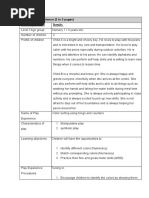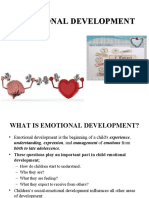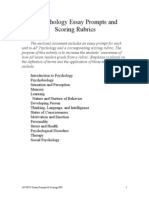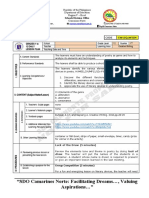Emotional Development
Uploaded by
HumaEmotional Development
Uploaded by
HumaEmotional development
Emotional development involves learning what feelings and
emotions are, understanding how and why they occur,
recognising your own feelings and those of others, and
developing effective ways for managing those feelings.
What is emotional Influences on emotional expression include:
development? • values and beliefs about appropriate and
inappropriate ways of expressing emotions that
children and young people learn from families and
Emotional development begins at birth
educators
Emotional development is a complex process that
• how effectively children and young people’s
begins in infancy and continues through adulthood.
emotional needs are usually met
The first emotions that can be recognised in babies
include joy, anger, sadness and fear. As children’s • children and young people’s temperaments
sense of self develops, more complex emotions like
• cultural norms
shyness, surprise, elation, embarrassment, shame,
guilt, pride and empathy emerge. School-aged • emotional behaviours that children and young
children and young people are still learning to people have learned through observation or
identify emotions, understand why they happen, and experience
how to manage them appropriately.
• the extent to which families are under various
Emotional expression includes several kinds of stress.
components such as:
The rate of emotional development in children and
• physical responses (like heart rate, breathing and young people varies from person to person. Some
hormone levels) children may show a high level of emotional skill
development while quite young, whereas others may
• behavioural displays of emotion
still be developing the capacity to manage their
• feelings that children and young people recognise emotions well into adolescence.
and learn to name
• thoughts and judgments associated with feelings
• action signals (for example, a desire to approach,
escape or fight).
Emotional development and Help children and young people recognise and
understand emotions
sense of self Talking to children and young people and teaching
them about emotions helps them to become more
A person’s sense of self is strongly influenced by
aware of their own behaviour, as well as that of
their perception of themselves.
others. It also helps them to better manage their
Knowing that they can be successful at what they own emotions over time.
do allows children and young people to Set limits
feel competent and confident – which, in turn,
affects their emotional development. Let children and young people know that it’s normal
and OK to have a range of emotions and feelings.
Children and young people who don’t have many Teach language and skills for dealing with strong or
experiences of success can experience difficult emotions, such as anger and frustration, in a
disappointment more often, which can lead to positive way. It’s also important to set limits on
development of a negative sense of self. By being aggressive, unsafe or inappropriate behaviours.
supported to learn to value their own strengths and
efforts, as well as those of others, children and Be a role model
young people develop resilience to bounce back Showing children and young people different ways
from challenges and hardship. you understand and manage emotions helps them
learn from your example. If you lose your temper,
How can educators support apologise and show how you might make amends.
emotional development in Be You Professional Learning
children and young people? Check out content on social and emotional
learning (SEL) and teaching for resilience in the
Providing effective support for children and young Learning Resilience domain.
people’s emotional development starts with paying
attention to their feelings and noticing how they References
manage them.
Collaborative for Academic, Social, and Emotional
Many learning communities incorporate specific
Learning (CASEL) (2018). Core SEL
programs to teach social and emotional skills. These
competencies. Chicago: CASEL. Retrieved from
skills can also be taught and learned through
https://casel.org/core-competencies/
everyday interactions.
National Scientific Council on the Developing Child
Tune in to children and young people’s feelings and
(2004). Young children develop in an environment of
emotions
relationships. Boston: Harvard University. Retrieved
Some emotions are easily identified, while others are from
less obvious. Tuning in to children and young http://developingchild.harvard.edu/resources/wp1/
people’s emotions involves looking at their body
Shonkoff, J., & Phillips, D. (2000). From neurons to
language, listening to what they’re saying and how
neighbourhoods: The science of early childhood
they’re saying it, and observing their behaviour. This
development. Washington: National Academy Press.
allows you to respond more effectively to their
needs and to offer more specific guidance to help
them manage their emotions.
For more information visit
beyou.edu.au
You might also like
- The Science of Learning Physics Cognitive Strategies For Improving Instruction 9811226547 9789811226540 - CompressNo ratings yetThe Science of Learning Physics Cognitive Strategies For Improving Instruction 9811226547 9789811226540 - Compress211 pages
- Emotional Intelligence: The Development of Emotional IntelligenceFrom EverandEmotional Intelligence: The Development of Emotional IntelligenceNo ratings yet
- Art Time and Technology (Culture Machine)No ratings yetArt Time and Technology (Culture Machine)202 pages
- Humanistic Psychology - Wikipedia, The Free EncyclopediaNo ratings yetHumanistic Psychology - Wikipedia, The Free Encyclopedia5 pages
- Raising An Emotionally Intelligent Child: What It Actually TakesFrom EverandRaising An Emotionally Intelligent Child: What It Actually TakesNo ratings yet
- Early Is Better: Emotional Intelligence For Kids And TeenagersFrom EverandEarly Is Better: Emotional Intelligence For Kids And TeenagersNo ratings yet
- Brown Vintage Empty Scrapbook Paper A4 DocumentNo ratings yetBrown Vintage Empty Scrapbook Paper A4 Document11 pages
- Nurturing Emotional Intelligence in Children: A Comprehensive Guide."From EverandNurturing Emotional Intelligence in Children: A Comprehensive Guide."No ratings yet
- Exploring Emotions: How you can help children to recognise and talk about their feelingsFrom EverandExploring Emotions: How you can help children to recognise and talk about their feelingsNo ratings yet
- Raising Emotionally Intelligent Kids: The Secret to Building Trust, Respect, and Lifelong BondsFrom EverandRaising Emotionally Intelligent Kids: The Secret to Building Trust, Respect, and Lifelong BondsNo ratings yet
- Educating for Emotional Intelligence: Building Relationship SkillsFrom EverandEducating for Emotional Intelligence: Building Relationship SkillsNo ratings yet
- Emotional Intelligence Unlocked: Building Strong Foundations for KidsFrom EverandEmotional Intelligence Unlocked: Building Strong Foundations for KidsNo ratings yet
- Raising Responsible Adults: A Comprehensive Guide to Preparing Your Children for LifeFrom EverandRaising Responsible Adults: A Comprehensive Guide to Preparing Your Children for LifeNo ratings yet
- Submitted TO: Javed Iqbal: Course: Human Development and Learning (8610)No ratings yetSubmitted TO: Javed Iqbal: Course: Human Development and Learning (8610)17 pages
- Emotional Intelligence: The Key to Personal and Professional SuccessFrom EverandEmotional Intelligence: The Key to Personal and Professional SuccessNo ratings yet
- Gifted Children Decoded: Nurture Intellectual, Emotional, and Social Growth Through Simple Effective Strategies and AdvocacyFrom EverandGifted Children Decoded: Nurture Intellectual, Emotional, and Social Growth Through Simple Effective Strategies and AdvocacyNo ratings yet
- Effective Strategies for Raising Emotionally Intelligent Children:A Practical Guide with Simple Discipline ToolsFrom EverandEffective Strategies for Raising Emotionally Intelligent Children:A Practical Guide with Simple Discipline ToolsNo ratings yet
- Emotional Literacy: 45 lessons to develop children's emotional competenceFrom EverandEmotional Literacy: 45 lessons to develop children's emotional competenceNo ratings yet
- Daring to Dream: A Teen's Journey in Skills Acquisition and ExplorationFrom EverandDaring to Dream: A Teen's Journey in Skills Acquisition and ExplorationNo ratings yet
- Developmental aspects of emotional neuroscienceNo ratings yetDevelopmental aspects of emotional neuroscience2 pages
- Emotional Foundations: Parenting Strategies for Building Strong KidsFrom EverandEmotional Foundations: Parenting Strategies for Building Strong KidsNo ratings yet
- the four before: A Resource · A Reference · A Refresher For Instructional StakeholdersFrom Everandthe four before: A Resource · A Reference · A Refresher For Instructional StakeholdersNo ratings yet
- The Mindful Child: Strategies for Nurturing Mental Growth and Child Development: Health & WellnessFrom EverandThe Mindful Child: Strategies for Nurturing Mental Growth and Child Development: Health & WellnessNo ratings yet
- Better Kids Become Better Adults: A Complete Guide To Teach Kids How to Identify and Manage Emotions, Generate Empathy, Kindness, and Compassion Towards the World Around ThemFrom EverandBetter Kids Become Better Adults: A Complete Guide To Teach Kids How to Identify and Manage Emotions, Generate Empathy, Kindness, and Compassion Towards the World Around ThemNo ratings yet
- The Feelings Activity Book for Toddlers: 50 Fun Activities to Identify, Understand, and Manage Big FeelingsFrom EverandThe Feelings Activity Book for Toddlers: 50 Fun Activities to Identify, Understand, and Manage Big FeelingsNo ratings yet
- Parenting a Rebellious Teenager: Proven Strategies to Transform Conflict into Connection and Raise Responsible Young AdultsFrom EverandParenting a Rebellious Teenager: Proven Strategies to Transform Conflict into Connection and Raise Responsible Young AdultsNo ratings yet
- Parenting Toddlers Years Survival Guide for First-Time Dads: Navigating the Turbulent Toddler Terrain: A First-Time Dad's Survival GuideFrom EverandParenting Toddlers Years Survival Guide for First-Time Dads: Navigating the Turbulent Toddler Terrain: A First-Time Dad's Survival GuideNo ratings yet
- Part B F. Study Sheet Spring 2024 - 1746353166No ratings yetPart B F. Study Sheet Spring 2024 - 174635316610 pages
- Social and Emotional Learning For Educators DoneNo ratings yetSocial and Emotional Learning For Educators Done5 pages
- Raise Emotionally Empowered Kids: Develop Mentally Strong, Resilient Children in the Digital WorldFrom EverandRaise Emotionally Empowered Kids: Develop Mentally Strong, Resilient Children in the Digital WorldNo ratings yet
- Harmonious Parenting: A Guide to Nurturing Strong, Empathetic Children Through Thoughtful ParentingFrom EverandHarmonious Parenting: A Guide to Nurturing Strong, Empathetic Children Through Thoughtful ParentingNo ratings yet
- The Ultimate Guide to Promoting Prosocial Behaviour in PreschoolersFrom EverandThe Ultimate Guide to Promoting Prosocial Behaviour in PreschoolersNo ratings yet
- The Emotion Toolbox Practical Strategies For Parents and Children - 67291342No ratings yetThe Emotion Toolbox Practical Strategies For Parents and Children - 6729134249 pages
- Emotional Intelligence in the classroom: Creative Learning Strategies for 11-18 year oldsFrom EverandEmotional Intelligence in the classroom: Creative Learning Strategies for 11-18 year olds3/5 (1)
- DBT Skills Workbook for Teens with Anxiety and Negative Emotions: Managing Anxiety and Transforming Negative Emotions with Dialectical Behavior Therapy (DBT) SkillsFrom EverandDBT Skills Workbook for Teens with Anxiety and Negative Emotions: Managing Anxiety and Transforming Negative Emotions with Dialectical Behavior Therapy (DBT) Skills5/5 (1)
- Barnes and Bloor Relativism Rationalism and The Sociology of KnowledgeNo ratings yetBarnes and Bloor Relativism Rationalism and The Sociology of Knowledge14 pages
- Southern Luzon Technological College Foundation Inc 1No ratings yetSouthern Luzon Technological College Foundation Inc 193 pages
- Gretchen Dice M. Parcon, LPT: by God'S Grace, I Can Pass and Top The Let 2019No ratings yetGretchen Dice M. Parcon, LPT: by God'S Grace, I Can Pass and Top The Let 201915 pages
- AP PSYCH Essay Prompts and Scoring 2007No ratings yetAP PSYCH Essay Prompts and Scoring 200716 pages
- Correlations Between The Wide Range Intelligence Test (WRIT) and100% (1)Correlations Between The Wide Range Intelligence Test (WRIT) and42 pages
- How To Train AI Models Step by Step EffectivelyNo ratings yetHow To Train AI Models Step by Step Effectively8 pages
- Project: Vlog (Promoting Healthy Home, School, and Community)No ratings yetProject: Vlog (Promoting Healthy Home, School, and Community)1 page

























































































